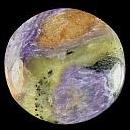|
Click on a letter above to view the list of gems. |
|
|
|
|
|
|
|
|
Tinaksite |
|
| | |
| Discovered in 1965; IMA status: Valid (IMA approved) | ||
|
| ||
|
Chemistry |
|
|
| |
|
K2Na(Ca,Mn2+)2(Ti,Fe)Si7O19(OH) | |
|
|
Potasium Sodium Calcium Manganese Titanium Iron Oxide Silicate Hydroxide |
|
Molecular Weight: |
751.73 gm |
|
Composition: |
Potassium |
10.40 % |
K |
12.53 % |
K2O |
|
|
Sodium |
3.06 % |
Na |
4.12 % |
Na2O |
|
|
Calcium |
9.33 % |
Ca |
13.05 % |
CaO |
|
|
Titanium |
5.41 % |
Ti |
9.03 % |
TiO2 |
|
|
Manganese |
1.83 % |
Mn |
2.36 % |
MnO |
|
|
Iron |
1.11 % |
Fe |
1.43 % |
FeO |
|
|
Silicon |
26.15 % |
Si |
55.95 % |
SiO2 |
|
|
Hydrogen |
0.13 % |
H |
1.20 % |
H2O |
|
|
Oxygen |
42.57 % |
O |
|
|
|
|
|
100.00 % |
|
99.68 % |
= TOTAL OXIDE |
|
|
|
||||
|
Classification |
|
|
| |
|
Silicates (Germanates) | |
|
8/F.22-30 | |
|
|
9 : SILICATES (Germanates) |
|
Related to: |
Tinaksite Group. |
|
|
|
|
Crystal Data |
|
|
|
|
|
As well-formed long prismatic crystals, to 15 cm; commonly as bundles and rosettes of radiating crystals, or compact fibrous aggregates, to 10 cm. |
|
|
None |
|
|
|
|
|
Physical Properties |
|
|
|
|
|
{010} Perfect, {110} Indistinct |
|
|
Fibrous |
|
|
Brittle |
|
|
6.0 |
|
|
2.82 - 2.90 (g/cm3) |
|
|
None |
|
|
Barely Detectable; GRapi = 148.49 (Gamma Ray American Petroleum Institute Units) |
|
|
|
|
|
Optical Properties |
|
|
|
|
|
Pink, Pale Yellow, Light Brown, Orange |
|
|
Transparent to Translucent |
|
|
Vitreous on cleavages |
|
|
1.593 - 1.666 Biaxial ( + ) |
|
|
0.0730 |
|
|
Strong |
|
|
X = Y = colorless; Z = pale orange-yellow or orange-brown |
|
|
|
|
|
Occurances |
|
|
|
|
|
Geological Setting: |
An accessory mineral in potassic feldspar metasomatites at the contact with limestones (Murun massif, Russia). |
|
Common Associations: |
Potassic Feldspar, Aegirine, Quartz, Canasite, Xonotlite (Murun massif, Russia); Orthoclase, Pyroxene, Aegirine, Astrophyllite, Hisingerite (Khibiny massif, Russia). |
|
Common Impurities: |
Al, Fe, Mg, H2O |
|
Type Locality: |
Murunskii Massif, Chara and Tokko Rivers Confluence, Aldan Shield, Saha Republic (Sakha Republic; Yakutia), Eastern-Siberian Region, Russia |
|
Year Discovered: |
1965 |
|
View mineral photos: | |
|
|
|
|
More Information |
|
|
|
|
|
| |
|
|
|
|
Tinaksite
is found at only two localities in the world, and both
are in Russia; in the Murun massif, southwest of Olekminsk,
Yakutia, and on Mt. Rasvumchorr, Khibiny massif, Kola
Peninsula. |
|
|
We
have not photographed our Tinaksite gems. Please
check back soon. |

